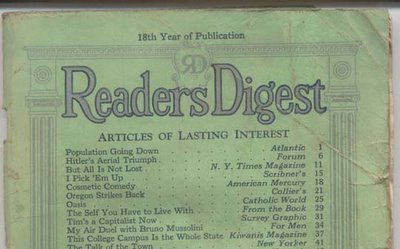Messages from another time

I went to an antique shop on an impulse Sunday afternoon and found a time capsule.
Three editions of Readers Digest were tied together and on sale for a buck - nothing unusual, I guess, except they were from June 1935, March 1939 and November 1941. They're like no Readers Digests I had ever seen - no advertising, few illustrations and no slick paper, the only embellishments a somewhat heavier-stock cover and the words "Articles of Lasting Interest" under the name of the magazine on the cover, which also served as the table of contents.
The articles are of lasting interest because of what they tell us about those times. An early review shows two especially interesting articles in the 1935 edition. In "Better Days Are Coming," B.C. Forbes ("Since 1916 editor and publisher of Forbes Magazine") argues that while more families were living on public relief than at any time in the nation's history, there were signs of life in the economy.
"Despite the drain of five painfully lean years, our savings deposits amount to $22 billion, a reduction of only 21 percent from the peak reached during the wild 1928-29 boom ... In 10 recent weeks fully $350 million of foreign gold poured into America. Our banking laws and regulations are such that each $100 of gold can theoretically be made the basis for granting $1,000 of credit. This means that recent importations of gold alone are sufficient to finance almost the entire $4 billion Congress recently allocated to President Roosevelt for work-giving purposes."
Ah, Roosevelt. Things are looking up, but "this promising forward movement suffered a jolt when President Roosevelt announced that he hoped to see the government establish all over the country public-utility experiments similar to the Tennessee Valley Authority, to compete with existing companies." Still, Forbes believed that once Americans regained their confidence and resume normal spending and living, "we shall reach heights of prosperity beyond anything enjoyed in 1928-29 or in any earlier period in our history."
The real eye-opener in that 1935 magazine is the seven-page excerpt from Gen. Smedley D. Butler's book "War is a Racket," in which the World War hero catalogs the skyrocketing profits that some corporations enjoyed from 1914 to 1918, while the war was in progress. It seems at least 21,000 new millionaires and billionaires made their fortunes during the war.
"The normal profits of a business concern in the United States are 6, 8, 10 and sometimes even 12 percent," Butler wrote. "But war-time profits - ah! that is another matter - 20, 60, 100, 300 and even 1,800 percent - the sky is the limit. All that the traffic will bear. Uncle Sam has the money. Let's get it."
Butler warned that war drums were starting to be beaten over the threat of Japan, and - well, I probably should return to his article another day or this piece will be way too long. The man who had been decorated for his actions in combat two decades earlier cautioned against being talked into waging a new war for the benefit of those war profiteers.
Times changed. In 1939 there were articles about Hitler's buildup of air strength, the mysterious life of the emperor of Japan, and pro and con articles on the question "Should We Act to Curb Aggressor Nations?" By November 1941 the "cons" were silent; the edition opens with an entreaty by Wendell Wilkie, candidate for president the year before, that America take the initiative against Hitler, and there are articles called "Japan Risks Destruction" and "Need We Fear Our Alien Population?"
Another 1941 article warns that morale among soldiers is at an alarming low: "So far as the men can see, the Army has no goal. It does not know whether it is going to fight, or when or where ... Few of the men believe that the emergency is as serious as President Roosevelt insists."
As I said, a time capsule. It'll be interesting and instructive to spend more time with these old magazines, knowing how the drama played out.



2 Comments:
From Forbes:
Our banking laws and regulations are such that each $100 of gold can theoretically be made the basis for granting $1,000 of credit.
This was one of the great things about having the private banks of the Federal Reserve put in charge of our banking system - debt. H.L. Mencken railed against FDR and his idiotic Brain Trust and their socialist policies only to have him re-elected, but as Mencken pointed out, "not a single one of the problems that confronted Dr. Roosevelt and his necromancers on March 4, 1933, has been solved. They have got rid of more than $8,000, 000,000 of the taxpayers' money to date, and are preparing to grab and waste $8,000,000,000 more, but the state of the nation is worse than it was when they began.
Interesting and instructive, indeed! I remember enjoying Reader's Digests a few decades back; it wasn't until after that I learned that its editor was someone who'd been a Rand fan (I'm not recalling the name).
Post a Comment
Subscribe to Post Comments [Atom]
<< Home